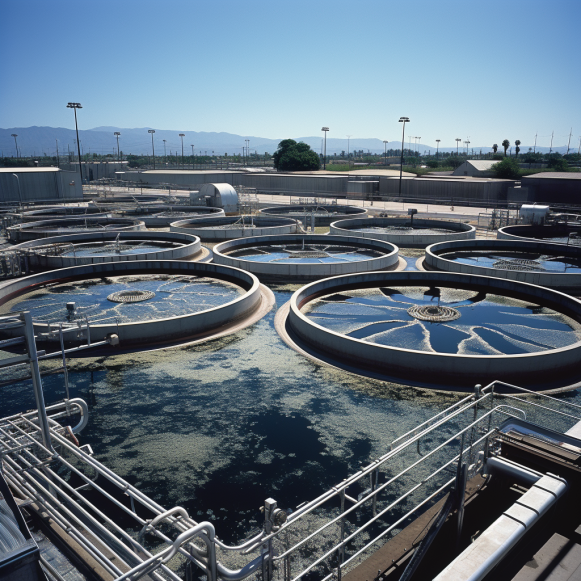Fighting future ‘red tides’ in San Francisco Bay

Reductions in nutrient pollution are already underway — but a real cure could cost up to $15 billion. Is it worth it?
The San Francisco Bay’s largest sources of nutrient pollution and algae blooms, 37 different sewage treatment plants, are cleaning up their act.
Faced with two blooms known as “red tides,” which are deadly to marine life, officials will soon propose the first-ever restrictions on the release of nutrients such as nitrogen into the Bay, a vast body of water that has long seemed impervious to trouble.
Nitrogen is not a poison; rather, it is required for a healthy ecosystem. However, too much of it, when discharged in wastewater from human urine, triggers a complex chain of events that causes too much algae to grow, depleting oxygen and killing marine life. Last year, a harmful bloom washed ashore piles of stinking fish carcasses. A smaller bloom appeared and then vanished this summer.
“The science tells us that we need to reduce nutrient loads as soon as possible,” said Eileen White, executive director of the San Francisco Bay Regional Water Quality Control Board, which oversees sewage treatment plants. “What has happened is a game-changer.”
More than two-thirds of the nitrogen in the region comes from sewage treatment plants, which dump approximately 50,000 kilograms into Bay waters every day. While many natural factors contribute to the formation of a red tide, which is named after the discolored water, these nutrient releases are man-made — and, experts say, can be controlled.
Approximately 14 Bay Area treatment plants have already modernized their facilities to clean up their chocolate-colored sludge, using bacteria and aeration techniques to convert nitrogen from a liquid to a gas before safely releasing it into the air. Several others are planning upgrades and researching treatment wetlands.
Others, however, are falling behind.
A thorough cleanup will be very expensive, raising rates for ratepayers. The total cost of reducing nitrogen emissions by half could reach $11.5 billion; more modest reductions of 7% to 20% would cost $220 million to $870 million, respectively. The most drastic cut — 82% — could cost nearly $15 billion.
And the payoff may not be obvious right away. Until last year, there had been no dramatic red tide die-offs of marine life in the Bay. Scientists are attempting to determine whether these are extremely rare occurrences or the start of a trend. There are hints, but no proof, that climate change may cause more outbreaks.
“It’s a huge challenge… with a lot of uncertainty,” said Lorien Fono, executive director of the Bay Area Clean Water Agencies, whose members serve more than 7.1 million people with sewer services. “However, by working together, we may be able to develop a regional approach to nutrient reduction.”
According to an analysis by scientists at San Francisco Baykeeper, an environmental group that monitors water conditions in the Bay, July’s red tide algae bloom faded without a repeat of last summer’s toll of thousands of dead fish and other marine creatures.
But summer isn’t over yet. Authorities are taking a closer look because of increased algae concentrations in the 2000s, as well as these recent outbreaks.
Discharge limits have aided in the recovery of ecological disasters in Tampa Bay, Long Island Sound, and other estuaries across the country. Key fish species have rebounded in the Chesapeake Bay, more seagrass is growing, and the water contains more life-giving oxygen.
Limits have never been required in San Francisco Bay. It has strong tides, which reduce nitrogen concentrations. The water is cloudy because of millions of tons of mud, gravel, and sand from Gold Rush mining. It also has a large population of organisms that feed on algae, such as clams.
“The key factors that can trigger harmful algae blooms have rarely all lined up to allow for a very, very large problem to actually occur,” said David Senn of the San Francisco Estuary Institute, who leads the San Francisco Bay Nutrient Management Strategy, a regional initiative to develop the science needed to make informed decisions about nitrogen loads.
However, that tenacity may be fading. Water clarity is improving as a result of upstream dams capturing sediment. Clam populations are on the decline. Water temperatures may rise as a result of climate change.
The region’s 50-year-old treatment facilities are also aging, presenting opportunities for improvements, according to Fono.
Nitrogen discharges will be limited, according to White. Every five years, the San Francisco Bay Regional Water Quality Control Board issues new permits with new regulatory requirements. The current permits will run out next year.
“We tried to be a progressive thinker,” said Jimmy Dang of the Oro Loma/Castro Valley Sanitary Districts, which upgraded its decades-old facility to remove nearly 95% of nitrogen from its discharge flow, resulting in a 7% price increase for ratepayers. “It was a deliberate decision to look at the Bay’s environment ahead of any limits that were coming down the pipeline.”
“The nitrogen becomes gas and disappears” in the company’s new $25 million facility, he says.
Around two decades ago, the San Jose-Santa Clara Regional Wastewater Facility, which sits on the edge of the shallow and slow-moving South Bay, began removing nitrogen discharges. With more recent innovations, approximately 85% of the nitrogen has been removed.
Last year, South San Francisco and San Bruno finished building a technology that reduced nutrients by 85%.
According to the most recent Bay Area Clean Water Agencies report, Palo Alto and its partners are planning a $200 million upgrade to their Regional Water Quality Control Plant. West County Wastewater, which serves San Pablo, Richmond, and Pinole, has already finished improvements to its plant. Dublin San Ramon District is addressing the issue with a recycled water program that uses nitrogen to fertilize fields and landscaping. The project in San Leandro, which is currently under construction, is expected to be completed this year. San Mateo’s upgrade will begin in 2021.
According to the report, the two largest dischargers, the East Bay Municipal Utility District and the San Francisco Public Utilities Commission, are off to a slower start. EBMUD is currently pilot testing treatment of approximately 10% of its flow, which should result in some savings.
“It is very expensive,” Fono said. “However, the entire community takes this very seriously.”
How much cost reduction is required, given the enormous cost? Senn and his Nutrient Management Strategy colleagues are investigating this. They are creating computer simulations of the ecosystem’s gradual decline as well as more catastrophic red tides to better understand whether massive die-offs will be rare occurrences or something more common. The goal is to collect the information required to support major management decisions.
“What are the best investments for the region to make,” Senn inquired, “to try to get the biggest improvements?”
“How do we think through something that’s never happened before — something that would cost $10 billion or more to prevent from happening again?” Senn inquired. “And at what pace do we need to get there?”




